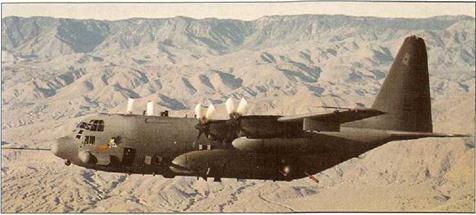Lockheed Martin 0130 Specials
|
|
T |
he versatility of the basic C-130 transport has led to conversions for specialised missions. The initial AC-130A Spectre ginship version introduced specialised sensors, including a searchlight, ignition sensors, a FUR and an LLLTV camera. Successive AC-130E and AC-130H variants ntroduced improved armour, avionics, engines and armament (a 105-mn howitzer and 40-mm Bofors cannon). The current AC-130U Spectre version, developed by Rockwell, has a single GAU-12 25-mm cannon replacing the two 20-mm M6′-s of previous aircraft. Sensors include APG-180 radar, AAQ-117 FUR, all-light – evel TV and ALQ-172 jammer package, The USAF Special Operations Command has acquired 13 AC-130Us, to replace the AC-130A and allow the AC-1 ЗОН to be transferred to the Reserve
Several in-service variants carry the designation EC-130. These include the; EC-130E (ABCCC) Airborne Battlefield Command and Control Center; the EC-130E(CL) ‘Senior Scout’ Elint platform; the EC-130E(RR) ‘Rivet Rider’ TV and radio rebroad cast ‘psy-war’ aircraft; and the EC-130H ‘Compass Call’ stard-off communications jamming duties.
Long-range SAR var’ants include the HC-130H, with a large radar above the forward fuselage, the similar HC-130H-7 for the USCG, and the HC-130N and HC-130P (HDU-euuipped and used to refuel rescue helicopters). The HC-130H(N) has modernised avionics and lacks Fulton gear, but is equipped with underwing HDUs. Dedicatee tankers
inc ude the KC-130B KC-130F and KC-130T and the stretched KC-130T-30H (a I acquired by ‘.he US Navy and Marine Corps) Not in US service, the KC-130H (similar to the KC-130R) has oeen widely exported.
The *irst MC-130E special forces insertion aircraft served in Vietnam, equipped with Fulton STAR recovery gear for retrieval of downec aircrew/recce troops. Currently there are 13 MC-130E Combat Talon I variants in service with AFSOC including; the MC-130E-C (with Fulton fitted), MC-130E-S and MC-130E-Y (no Fulton). The C-130H was used to produce 24 MC-130H Combat Talon lls, all with a distinctive long nose housing the APQ-170 terrain-following radar, and an AAQ-15 FLIR turret underneath. The first MC-130Hs arrived in 1991
AFSOC has taken on the HC-130N and HC-13QP aircraft and transferred them to the special ^orces rcle, as the Combat Shadow. They have been ungraded to SOFl standard by the removai of the large dorsal housing that once contained the Cook aerial tracker system, and adding an undernose FUR and other specialist mission systems.
The EC-130(RR) carries large podded antennas on its tail and underwing for its role as a flying TV and radio station, conducting ‘psychological operations’.
|













